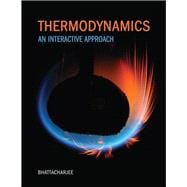For the thermodynamics course in the Mechanical & Aerospace Engineering department. This text also serves as a useful reference for anyone interested in learning more about thermodynamics.
¿
Thermodynamics: An Interactive Approach employs a layered approach that introduces the important concepts of mass, energy, and entropy early, and progressively refines them throughout the text. To create a rich learning experience for today’s thermodynamics student, this book melds traditional content with the web-based resources and learning tools of TEST: The Expert System for Thermodynamics (www.pearsonhighered.com/bhattacharjee)–an interactive platform that offers smart thermodynamic tables for property evaluation and analysis tools for mass, energy, entropy, and exergy analysis of open and closed systems.
¿
Beside the daemons–web-based calculators with a friendly graphical interface–other useful TEST modules include an animation library, rich Internet applications (RIAs), traditional charts and tables, manual and TEST solutions of hundreds of engineering problems, and examples and problems to supplement the textbook. The book is written in a way that allows instructors to decide the extent that TEST is integrated with homework or in the classroom.
¿
MasteringEngineering for Thermodynamics is a total learning package. This innovative online program emulates the instructor’s office—hour environment, guiding students through engineering concepts from Thermodynamics with self-paced individualized coaching.
¿
Teaching and Learning Experience
To provide a better teaching and learning experience, for both instructors and students, this program will:
- Personalize Learning with Individualized Coaching: MasteringEngineering emulates the instructor’s office-hour environment using self-paced individualized coaching.
- Introduce Fundamental Theories Early: A layered approach introduces important concepts early, and progressively refines them in subsequent chapters to lay a foundation for true understanding.
- Engage Students with Interactive Content: To create a rich learning experience for today’s thermodynamics student, this book melds traditional content with web-based resources and learning tools.
¿
Note: You are purchasing the standalone text. MasteringEngineering does not come automatically packaged with the text. To purchase MasteringEngineering, search for ISBN-10: 0133807975 / ISBN-13: 9780133807974. That package contains ISBN-10: 0130351172 / ISBN-13: 9780130351173 and ISBN-10: 0133810844 / ISBN-13: 9780133810844. MasteringEngineering is not a self-paced technology and should only be purchased when required by an instructor.
¿








